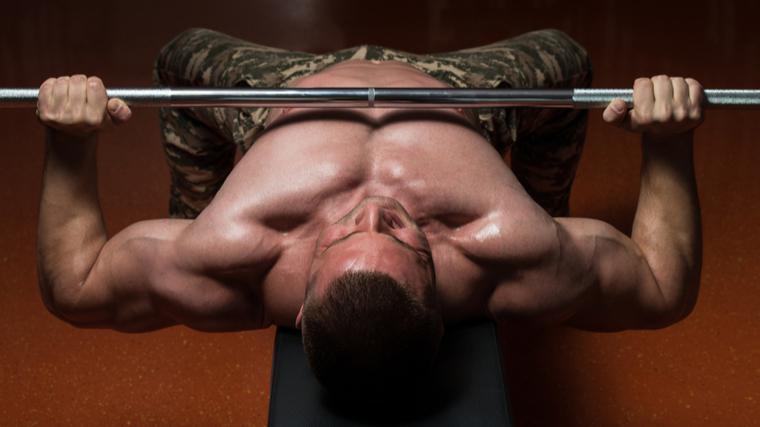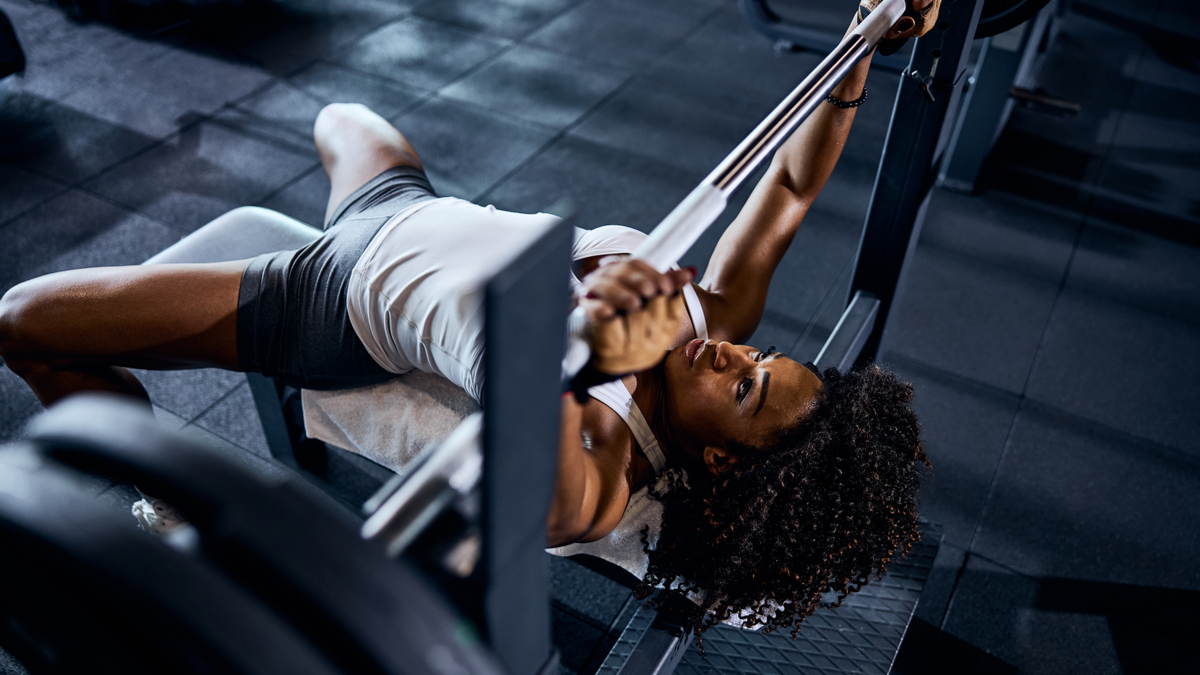Products You May Like
The bench press is the reigning king of upper body barbell exercises for many lifters. Even non-lifters are familiar with muscular athletes demonstrating their strength performing a bench press. It’s almost universally recognized as the way to build your chest, shoulders, and triceps.
Because you have the potential to put so much weight on the bar, the bench press is the greatest weapon in your exercise arsenal for gaining upper body strength and muscle mass. The bigger your bench, the bigger your upper body.
Here’s everything you need to know about performing the bench press to build a larger, stronger, more muscular chest.
How to Do the Bench Press
The bench press is a foundational exercise, beneficial for nearly every lifter in the gym. While some lifters over-focus on the exercise or misuse it, potentially leading to injury, it can play a key role in building muscle and strength for beginners as well as experienced lifters.
Learning proper techniques is essential for maximizing benefits and minimizing injury risk. the steps below will be your best place to start.
Step 1 — Initial Setup

Lie flat on the bench with your head beneath the bar. Put your feet up on the bench, grab the bar with an overhand, shoulder-width grip, and squeeze your shoulder blades together. Place your feet on the ground with your knees bent. Shifting your heels towards the bench will allow more lower body tension and force production.
Feel a strong connection to the bench through your entire body. Maintain your shoulder blades in a retracted position. Squeeze the bar with both hands to ensure tightness.
Form Tip: Your grip width can play a role in targeting or emphasizing certain muscles during the bench press. A wider grip will target the sternal head (inner portion) of the pecs and anterior delts (front shoulder) more, while a closer grip will focus more on the triceps and clavicular (upper) chest. (1) Begin training with a shoulder-width grip to build muscle coordination and reduce joint strain. Implement some slight changes in your grip as you become more experienced.
Step 2 — Lift Off

Actively press your feet into the floor, trying to get your heels flat on the ground. This creates tension throughout your lower body. Take a deep breath and hold it while lifting the bar off the rack by straightening your arms. The bar should be lined up above your shoulders with both arms locked out.
Form Tip: Avoid “pushing” the bar upward out of the hooks as you may protract (spread) your shoulder blades, putting the shoulder joints into a weaker position.. The bar should be set at a height that keeps your arms only slightly bent before unracking. If you have longer arms, use a top rack position. If you have shorter arms, use a lower rack position.
Step 3 — Descend With Control

With the barbell beginning directly over your shoulders, break at the elbows and lower the bar towards your mid-chest. Tuck your elbows slightly towards your feet. Keep your forearms vertical, and don’t let them collapse towards your head or feet as you continue to hold your breath at the bottom. Touch the bar to the same point on your chest on every rep.
Form Tip: The barbell should move down and slightly away from your shoulder level. Don’t attempt to lower the bar in a straight line to your upper chest. Doing so increases joint strain and decreases power output. Think of performing a very slight arc.
Step 4 — Press to Lockout

Once the barbell touches your chest, pause very briefly and then aggressively drive it back to the starting position. Release your breath as you press up. The barbell should move up and back towards your head. Your shoulders, elbows, and wrists should end up in vertical alignment, or “stacked”, when the rep is complete.
Form Tip: When pressing up, keep your butt in contact with the bench. Drive into the floor with your feet. This engagement from your lower body muscles will help you to drive the weight up, which is necessary to move heavier loads.
Bench Press Mistakes to Avoid
The bench press is a common exercise in most gyms, but it’s also common to see a few recurring technique errors. Here are the most common issues to avoid in order to get better results more efficiently.
No Upper Back Tightness
Upper back tightness is crucial for a safe and effective bench press. This is why it’s important to maintain retracted scapulae (shoulder blades) throughout the entire set. Emphasize consistent upper back tightness to better serve your shoulder health and to create more stability when lifting.

By retracting the scapulae, you activate the many muscles of the upper back like the traps, rear delts, and rhomboids. These muscles work with the chest and triceps to lower the bar under control and transition smoothly and powerfully into the press.
Avoid it: Make sure you are adequately activating your scapulae by “puffing your chest up” prior to gripping the bar. This is a very distinct cue to get your chest, shoulders, and upper back into a proper position.
No Leg Drive
Many people incorrectly think that performing the bench press with their ankles crossed and their feet up in the air will provide some sort of added benefit. It doesn’t. Picking up your feet leads to a decrease in stability, which hinders your ability to lift heavier weights.

This lack of stability also increases your risk of injury because the weight is solely supported by the shoulder joints and upper back muscles, rather than being distributed throughout the entire body from head to toe.
Avoid it: To maximize your stability, set your feet closer under your hips, rather than spread farther away in front of you. You should be able to maintain steady foot pressure into the floor. This added pressure will help transfer force from the floor up and into the bar when you drive through your legs.
Driving your feet into the floor also increases overall stability, much like how a table with four legs on the ground is more stable than a table with only three legs on the ground.
Weak Wrists
Having a firm grip and strong wrists is another overlooked component of the bench press. Many lifters tend to neglect “stacking” their wrists.

Instead, they allow their hands to bend backwards and palms to face the ceiling. This knuckles-back position creates an unstable wrist position and a weaker grip.
Avoid it: It may feel awkward at first, proper positioning often does, but vertically stacking your joints under the bar will create a stronger overall position to lift from. Try to “press” your thumb back into the bar, rather than only holding the bar with four fingers. This additional focus will force you to take a very firm grip and force your wrist into a stacked, neutral position without bending backwards.
Benefits of the Bench Press
The bench press allows you to load the upper body with heavier weights than any other exercise. This strengthens multiple muscle groups while also having the highest activation of the chest itself.

Maximizing Chest Strength and Growth
EMG research has shown the bench press to be incredibly effective at maximally activating the entire chest musculature. (2)(3) This means the bench press should be a staple in any programming focused on getting stronger and building muscle.
Time Efficient
Due to the high level of muscle activation, and the multiple muscles being engaged, the bench press is a wise choice for any lifter short on training time. If you find yourself performing limited exercises per session, then you need a movement that targets several muscles at once. The bench press is one of the most efficient upper body exercises.
Muscles Worked by the Bench Press
The bench press works multiple muscle groups on the upper body. This is why it’s a foundational movement for beginners to learn, as well as a reliable exercise for experienced lifters looking to maximize strength and muscle.

Pectoralis Major
As the main “chest” muscle, the pectoralis major’s primary function is to adduct the shoulder in the transverse plane — bring the elbows in closer to one another. The pec major has two heads, the sternal (mid and lower chest) and the clavicular (upper). Both pec heads are active in the bench press.
Anterior Delts
The entire shoulder muscle is recruited during the bench press, but the anterior (front) head to the deltoid is most prominently recruited during the exercise. The anterior deltoid’s primary function is to raise your arm up toward your head, as performed during the bench press motion.
Triceps Brachii
The triceps brachii extends the elbow and takes the arm from a bent to straightened position. This is an essential movement during the bench press, specifically during the lockout portion where the triceps are most involved.
Latissimus Dorsi
One of the largest muscles of the back are the lats. They bring the shoulder joint into a neutral position. When your shoulder is in a stretched position at the bottom of the bench press and your upper arm is “behind” your back”, your lats help to bring your arms back in line with your torso to resume the press.
Upper Back
The muscles of the upper back — the trapezius, rear deltoids, and rhomboids — work together to support shoulder stability during the bench press and to allow a full range of motion at the shoulder joint, in both the bottom and top positions.
Who Should Do the Bench Press
The bench press is an exercise everyone can use. Lifters who want to get into better shape and maximize their strength potential, athletes looking for speed and power, and competitive powerlifters who need to move maximum weight should all be training the bench press.
Training for Strength
Strength is movement-specific. (4) The skill of performing a heavy bench press is built by repetition after repetition. Any strength athlete, like a competitive powerlifter, who needs to get stronger at the bench press needs to practice the bench press. Prioritizing other exercises will not deliver the best results or build the most strength in this specific movement.
Training for Muscle
To increase muscularity, make the bench press a frequently recurring movement in your workouts. The muscle activation, number of muscles recruited, relatively long range of motion, and overall muscle-building stimulus provide a significant and unique muscular stress compared to other upper body exercises.
Training for Sport
Building power, strength, and speed throughout the entire upper body will be a benefit to any athlete in nearly any sport. The bench press is often seen in training specifically for sports with a high level of physicality such as football or rugby. Increasing the pushing power of the chest, shoulders, and arms carries over to the demands of the field.
How to Program the Bench Press
The barbell bench press can be programmed with a variety of set and rep schemes and should be performed early in a workout when your body is minimally fatigued and maximally focused to reap all of the benefits of this comprehensive movement.
Heavy Weight, Low Repetition
To maximize strength, four to six sets in the three to six rep range is a good place to start. Use a weight that leaves you with at least one rep left “in the tank” to avoid reaching muscular failure. A rest period of three to five minutes between each set will ensure you lift with maximum effort.
Moderate Weight, Moderate Repetition
To build a bigger chest, working for three to four sets in the six to 12 rep range will give you a nice bump in training volume, which is beneficial for building muscle. (5) The multiple sets and reps also allow you to develop your bench press technique without excessive fatigue from heavier weights.
Performing the bench press for higher repetitions (12 to 20, or more) is more appropriate for dumbbell or machine variations done later in the workout. This allows you to maximize the muscle-recruitment and heavier loading benefits of the standard barbell bench press when you are fresh at the start of your training.
Moderate Weight, Low Repetition
To build explosive power and speed, use a submaximal weight that can be moved at fast speeds while maintaining that speed during each rep of each set. A basic approach is to work for six to eight sets of two to five reps, using a weight that does not push you close to muscular failure. If you want to move like an athlete or train for sport, this method should be a staple.
Bench Press Variations
Whether you are just getting started on your lifting journey or have joint issues that prevent barbell training, you can still focus on effective bench press progressions and variations. These will allow you to train the muscles associated with the movement safely and progressively.
Bodyweight Push-up
Start from the ground up, figuratively and literally, with a fundamental bodyweight exercise that can be used daily. Perform full push-ups on your hands and toes, keeping a straight line throughout your entire body.
If needed, you can make the movement even easier by starting on your knees instead of your toes. You can also perform elevated push-ups, by pacing your hands on a bench or plyo box.
Resistance Band Push-up
A resistance band will not only increase the challenge to your chest, shoulders, and triceps but will also create a high level of upper pec activation.
The band will add resistance throughout the entire range of motion, increasing intensity as it stretches. In the top position, the band in under maximum stretch and is providing the most resistance. In the bottom position, the band is only slightly stretched and offers slight resistance. This is known as “accommodating resistance” which maximizes stress on the muscles and minimizes strain on the joints.
Weighted Push-up
Add even more resistance to the basic push-up by wearing a weighted vest, a loaded backpack, or simply balancing a weight plate on your mid- to lower back. The key with this exercise is maintaining a controlled tempo throughout each rep.
Pressing and lowering slowly will not only ensure the weight stays in place, but is also a technique to increase the overall time under tension, which makes the movement even more challenging.
Machine Chest Press
Using one of your gym’s chest press machines will challenge your muscles very similar to a bench press since you will be able to add a greater amount of load.
Make sure to use a pronated (palms down) grip so that you can best mimic the grip used in the bench press and recruit muscles in a similar way.
Bench Press Alternatives
While the bench press is a fundamental exercise with many benefits, some related exercises can deliver unique additional benefits while supporting the muscles involved in the bench press and complementing strength development.
Floor Press
The floor press is exactly as it sounds — performing the bench press on the floor without a bench. This can be a great tool that creates a partial range of motion, since you can only take your elbows to the floor. This makes it ideal for lifters who experience shoulder pain in the lowest range of motion of the bench press, when the bar touches the chest.
Focusing on the upper half of the range of motion also emphasizes triceps recruitment because the triceps are significantly recruited in that portion of the movement. This makes the floor press an effective choice for lifters needing to improve lockout strength in the full bench press.
Pin Press
The pin press is another partial range of motion movement, specifically used to assist with lockout strength in the top position. Some lifters can load up as much as 10-30% of the weight normally lifted on the full bench press.
The pin press is also an effective strength-building tool because you come to a complete dead stop without at the bottom, resting on the pins instead of supporting the weight with your muscles or joints. This avoids adding extra pressure at the bottom of the standard bench press.
Smith Machine Bench Press
The Smith machine is nearly identical to performing a barbell bench press. One of the biggest differences is that, due to the design of the machine and the limited recruitment of stabilizing muscles, the weight used in the Smith machine will not directly carryover to the weight used with a barbell.
However, the Smith machine can be a useful tool if you have any minor joint pains that may be aggravated when performing the free weight version, since the bar path is set in place, which allows a smoother transition of the movement.
FAQs
What should I do if I feel pain in my shoulders during the bench press?
First and foremost, it is important to address any joint pain with a medical professional and, at least temporarily, stop performing the bench press until you have an accurate diagnosis.
This does not mean the bench press is “bad” for you. In most cases, shoulder pain could be due to a breakdown in technique, incorrect set up, scapular instability, excessive load, or excessive volume.
Reviewing each of those parameters is essential to catching any problems before they become bigger issues. Focusing on the floor press instead of the barbell flat bench press could also be beneficial.
How many bench press variations should I perform in a workout?
Beginner lifters developing their base of strength and muscle can benefit from focusing only on the classic barbell bench press without any similar movements. It recruits a wide number of body parts and puts them under significant muscular stress. The focus and energy spent working on this big lift will pay dividends.
Experienced lifters training for muscular size may benefit from an overall program that incorporates more variety, while keeping the bench press as part of the program. Certainly, any lifter focused on increasing bench press strength should keep the exercise highly featured in their workout.
References
- Barnett C, Kippers V, Turner P. Effects of Variations of the Bench Press Exercise on the EMG Activity of Five Shoulder Muscles. J Strength Condit Res. 1995;9(4):222–7.
- Schick EE, Coburn JW, Brown LE, et al. A comparison of muscle activation between a Smith machine and free weight bench press. J strength Cond Res. 2010;24(3):779-784. doi:10.1519/JSC.0b013e3181cc2237.
- Alberton CL, Lima CS, Moraes AC De. RELATIONSHIP BETWEEN WORKLOAD AND NEUROMUSCULAR ACTIVITY IN THE BENCH PRESS EXERCISE. 2013;17(1):1-6.
- Wilson GJ, Elliott BC, Kerr GK. Bar path profile characteristics for maximal and submaximal loads in the bench press. International Journal of Sport Biomechanics; 5: 390-402. 1989
- Schoenfeld BJ, Contreras B, Krieger J, et al. Resistance Training Volume Enhances Muscle Hypertrophy but Not Strength in Trained Men. Med Sci Sports Exerc. 2019;51(1):94-103. doi:10.1249/MSS.0000000000001764
Featured Image: YAKOBCHUK VIACHESLAV / Shutterstock
